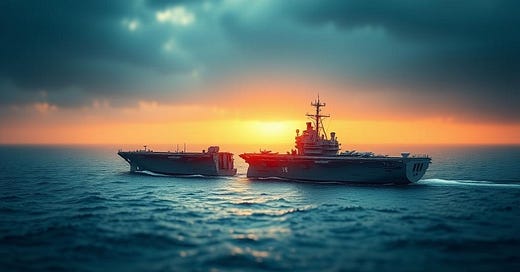Distributed Maritime Operations Isn't Happening
Even if logistics could support DMO, super carriers aren't the right weapons
Distributed maritime operations (DMO) that masses effort with widely dispersed but connected assets is not possible in the short term in INDOPACOM. The logistics cannot sustain it and that is unlikely to change. I'll add that DMO with platform-centric weapons undermines the operating concept, too.
This is no attitude for fostering DMO in the Navy:
[Fleet Forces Command Admiral Daryl] Caudle urged caution in launching into a “shipbuilding arms race,” saying the focus should be on U.S. capabilities per vessel.
“It’s tempting to get in a shipbuilding arms race where we really are trying to go tit-for-tat, where we’re judging the value of combat power of a naval force by the numbers,” said Caudle.
“I don’t think that’s a good strategy,” he said. “A better strategy is to build high-end, highly capable, large payload volume ships like we have,” citing Arleigh Burke-class guided-missile destroyers, as well as the U.S. fleet submarines [and] aircraft carriers.
The Navy, supported by other services, intends to fight China with DMO concepts:
DMO’s combat logic, which distributes naval combat power across the fleet and spreads the fleet out to complicate Chinese scouting and strike, is sound. However, the U.S. is highly unlikely to be able to sustain the DMO with its current maritime logistical system, which is already under peacetime stress, given numerical, manpower, and industrial constraints. A larger logistical force is unlikely in the short-term, reducing DMO’s combat viability. The result is a non-viable operational concept, which undermines U.S. strategy.
Yes. As I've noted, after the Cold War, American logistics in the Pacific was much more focused on the narrow Japan/South Korea region. Here's one example. It will take time to fix that. You can see efforts in the Philippines, Guam, and Australia, in particular. Even India is cooperating. But the ships to make the resupply runs are lacking and aren't going to appear any time soon. And what escorts them?
Once the logistics are fixed, the problem of preventing China from achieving its objective isn’t over (back to the initial article):
Geography complicates this task. China can concentrate forces against Taiwan faster than the US can counterattack given the PLA proximity to Taiwan and numerous PLA mainland bases. Chinese long-range missiles, long-range strike aircraft, and submarines are meant to keep U.S. forces at a distance by making operations within 600-1,000 kilometres of Taiwan too risky to undertake, particularly for U.S. Carrier Strike Groups. Concurrently, the U.S. must fight 8,000 kilometres from Hawaii or 2,500 kilometres from Guam. The U.S. has other outright-controlled or accessible bases in Japan’s home islands, the Ryukyus, and the Philippines, but all are within Chinese missile bombardment range.
Of course, what will the Navy do when it fights through that Chinese A2/AD belt?
Just as significant to the problems of logistics and geography is that so much of America's naval power is concentrated in a small number of hulls—the super carriers. These carriers and the ships that protect them are the pinnacle of platform-centric warfare:
The question of whether large aircraft carriers deserve to be the center of our future naval strategy is a fundamental question that has not been adequately explored. Network-centric warfare signals the beginning of the end for the United States Navy's large aircraft carriers. They will lose their value as an instrument of forward presence and become valuable targets that, if struck, will encourage an enemy at the outset of war by apparently demonstrating that American technological prowess can be nullified and beaten. In the long run, large aircraft carriers will add little to most offensive missions and will absorb scarce resources and assets simply evading attack rather than striking the enemy and contributing to victory.
DMO which spreads out the fleet while concentrating effort needs warships that can be spread out. Clearly, super carriers aren’t the system the Navy needs to rely on:
The issue shouldn't be about adding carriers to meet the need for naval power in response to global events. The question should be how do we meet the need with seapower. The RAND analyst, while not dunking on the carrier, correctly says:
Martin said the service could reevaluate its force structure and identify ways to meet requirements that carriers provide through alternative means.
And so here we are with an argument about embracing the logic of network-centric operations--which is a term of art numerous iterations out of style, but the same concept. Which may help us meet requirements through alternative means that carriers are currently intended to achieve.
Huzzah.
You can spread out ships that cost what a carrier and its air group cost. You cannot spread out a single carrier. And spreading out three or four carrier strike groups is not very distributed.
The extreme efforts to protect the carriers shows why they are not DMO assets which can be lost without harming the whole.
Sure, in the short run and in light of logistics problems, adding missiles tomorrow rather than beginning construction of more ships that won’t be ready for many years is probably correct. But that does run counter to the logic of DMO.
Not that carriers don't have a power projection role against small powers or great powers after enemy aero-naval power at sea is sufficiently destroyed. But that’s a different issue altogether. How many carriers are needed for that mission? And will a lower number free up the resources for DMO-appropriate naval assets?
NOTE: I made the image with the Substack capability.




